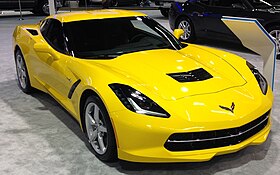Chevrolet Corvette (C7)
| Chevrolet Corvette | |
|---|---|

A yellow C7 on display at the Los Angeles Auto Show
|
|
| Overview | |
| Manufacturer | Chevrolet (General Motors) |
| Production | 2013–present |
| Model years | 2014–present |
| Assembly | United States: Bowling Green, Kentucky |
| Designer | Ed Welburn, Kirk Bennion, Tom Peters |
| Body and chassis | |
| Class | Sports car |
| Body style |
|
| Layout | FMR layout |
| Platform | Y-body |
| Powertrain | |
| Engine | |
| Transmission | |
| Dimensions | |
| Wheelbase | 106.7 in (2,710 mm) |
| Length | 176.9 in (4,493 mm) |
| Width | 73.9 in (1,877 mm) |
| Height | 48.6 in (1,234 mm) |
| Curb weight |
3,347 lb (1,518 kg) (Base) |
| Chronology | |
| Predecessor | Chevrolet Corvette (C6) |
3,347 lb (1,518 kg) (Base)
3,444 lb (1,562 kg) (Z51)
The Chevrolet Corvette (C7) is a sports car produced by Chevrolet. The seventh generation Corvette was introduced for the 2014 model year as the first to bear the Corvette Stingray name since the 1968 third generation model. The first C7 Corvette was delivered in the third quarter of 2013.
According to Motor Trend, GM executives have been planning the next-generation (C7) Corvette since 2007. On October 18, 2012, GM made an official news announcement confirming the seventh-generation Chevrolet Corvette would debut on Sunday evening, January 13, 2013, in Detroit at the North American International Auto Show. Chevrolet also showed the new Crossed Flags logo for the new 2014 Corvette. The car was originally planned for the 2011 model year, but was delayed.Mid-engine and rear-engine layouts had been considered, but the front-engine, rear-wheel drive (RWD) platform was chosen to keep costs lower. The C7's all-new LT1 6.2L Small Block V-8 engine develops 455 horsepower (339 kW) and 460 pound-feet (620 N·m) torque, which can accelerate the Corvette from 0-60 mph in 3.8 seconds. The C7's suspension consists of independent unequal-length double wishbones with transverse fiberglass mono-leaf springs and optional magnetorheological dampers, similar to its predecessor.
The C7 was designed not only to provide a bold styling statement, but also to incorporate an interior makeover that would put to rest past complaints about the quality of interior fit and finish. While overall the C7 attempts to provide an evolutionary redesign to an iconic theme, the car's designers took their inspiration from the 5th generation Chevrolet Camaro's squared rear end, incorporating aggressive angular elements that disappointed many Corvette enthusiasts. The C7 received instant criticism for some of the most overstyled elements of the car. "The rear contains what will surely be the C7's most controversial styling elements. It's all creases and vents back there, with aggressive trapezoidal taillights similar to those found on the current Camaro and quadruple-barreled tailpipes lined up in a neat row in the center of the rear valance", wrote Jason Kavanagh for Edmunds. Other designers found the C7's large front grille to be a rather unattractive reversion away from the Corvette's prior four generations of grille-less designs that pulled cooling air from beneath the nose. Functional aerodynamic aids are tacked on or cut into every body panel of the C7, often juxtaposed against sharp creases. This is a radical departure from the prior generations of Corvettes, whose clean muscular styling revealed no tack-on spoiler, few body panel creases, and only semi-functional gills for front brake cooling. In addition, past Corvette models minimized the size of headlamps or even hid them altogether. The C7 reverses that clean minimalist styling language with oversized, intricately styled headlamps with LED accents.
...
Wikipedia
